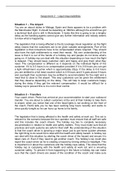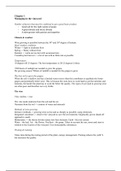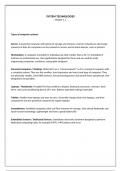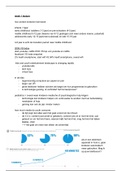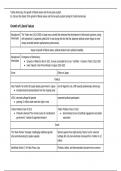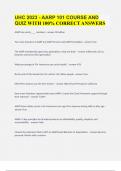Economic inequality – Problems and causes – text 1
Main question:
Is the issue of meritocracy changing over time? -> i.e Is individual merit, understood in terms of
ability, effort or educational attainment, growing in importance in processes of social selection?
Bell (1972): Education and qualifications serve as the basis on which individuals are allocated to
different positions in the division of labour and thus acquire differing levels of income and status. ->
Merit is understood in terms of educational attainment.
Young (1958): Apparent inequalities of opportunity in modern society do not in fact reflect any serious social
injustice, but simply the varying capacities of individuals, whatever their social origins, to take up the
opportunities that are available to them -> Merit = IQ + effort
Position of the article:
No reason to expect that the IMS (Increased merit-selection) thesis holds in the case of the UK in the time
period 1958-1970). While ability, effort, and educational attainment do clearly play a significant role in
determining employment prospects, and thus in mediating class mobility processes, there is no mechanism
apparent to us that would ensure that this role should steadily grow until merit understood in terms of these
criteria becomes totally dominant. Rather, our expectation would be that in modern societies the importance
of merit defined in this way, is likely to fluctuate over time, in relation to a variety of factors affecting the
economic/social/political conditions under which employing organizations operate and the labour and
personnel policies that they in turn adopt.
5 key variables involved to research this:
- Class origins
- Class destinations
- Ability
- Effort
- Educational attainment
Class origins and destinations
Goldthorpes class schema -> 11 classes and later 7 classes (People in employment)
So, looking at the class origins divided in 11 different classes and then looking in which class these
people were 15 years later. (So they take to ‘cohorts’ , the 1958 cohort and the 1970 cohort, in UK!)
They show a table in which u can see the class origins and their final destinations. They conclude:
There is by now much evidence to indicate that patterns of association between class origins and
destinations (relative mobility rates), tend to high a high degree of stability over time. Despite the
differences in absolute numbers changing over time, relative rates of class mobility of individuals can
be regarded as very largely the same. We are thus led on to the issue that: how far can the
inequalities in question can be accounted for in terms of merit.
Ability
General Ability Test and British Ability Scales-> good proxy for IQ score (ranging between 0-80)
The partial effects of ability on relative mobility chances could be said to show a general decline
between our two cohorts in the case of men and women alike. Among women born in 1958, ability
,played a quite substantial role in determining mobility chances: in particular the chance of being
found in Class 1 rather than in classes 2 or 3. However among women born in 1970, such ability
effects largely disappear. The obvious interpretation her is that women in the earlier cohort often
lacked educational opportunities appropriate to their ability, or chose not to take up such
oppirtunites, so that much schope still remained for their ability to influence their mobility
independently of education qualifications.
Effort
Academic Motivation Scale -> measuring responses to statements about school and schoolwork.
Motivational tests -> responses to a total of twenty items designed to test how far children see their
level of school achievement as lying within their won control or, rather, as being ‘externally’
determined (This last aspect is therefore bad for effort)
Educational Attainment
Measured by respondents’ highest educational qualifications (from ‘none’ to ‘degree level and
higher’)
As regards educational qualifications, the research suggests that their effects also tend to decline.
It can be seen that with the 1958 cohort for both men and women, educational attainment had a major impact
on mobility chances in at least two respects. Among men, education strongly differentiated their chances of
being found in Class 1 rather than in any other class, and in addition, their chances (or risks) of being found in
class 7. For women about the same holds. For the 1970 cohort, in contrast, educational attainment shows a
substantial impact on only 1 point. Education is most important in differentiating their chances of being found
in classes 1 2 and 3, rather than in other classes. Therefore, in the 1970, the effects of education appear
relatively modest.
SO: for members of the 1970 cohort, educational qualifications were neither so powerful nor so
discriminating in the ways in which they conditioned their relative mobility chances (compared to 1958)
It is evident that their findings can give little support to the IMS thesis, whether merit is defined in
terms of education or of ability and effort.
Also in both cohorts neither ability nor education do all that much to differentiate the chances of
individuals being found in unemployment rather than in employment within classes 4/5/6/7
Terms & Definitions
social stratification is a concept involving the "classification of persons into groups based on shared
socio-economic conditions ... a relational set of inequalities with economic, social, political and
ideological dimensions." It is a system by which society ranks categories of people in a hierarchy. For
example Upper class, Middle class, Lower class.
Dimensions of social stratification:
Income: wages or salaries and earnings from investments
Wealth: the value of money and other assets owned, minus outstanding debts
Prestige: The value and recognition people receive from other people in society
Education: The level of knowledge and skills obtained through intensive schooling
Ascription-based stratification: allocation depends on the characteristics a person is born with.
(closed society)
, Achievement-based stratification: allocation of rank depends on a person’s accomplishments.
(open society)
Social mobility
Meritocracy
Meritocracy: a society where status is made and responsibilities are given based on demonstrated
talent and ability (merit)
M. Young (1958): “IQ + Effort = Merit” (not education, but cognitive skills and effort)
Bell (1973): “The university has now become the arbiter of class position. As the gatekeeper, it has
gained a quasi-monopoly in determining the future stratification of society.”
Why no ‘full’ meritocracy?
- Employers still recruit on other factors than IQ and merit
- Mobility based on class is not the same as mobility based on status
- Compensatory strategies of higher class and status groups (use distinction in e.g. language,
cultural consumption, etc If distinction based on wealth is not longer possible) avoiding being
downwardly mobile
- Assortative mating (people marry within classes)
Structural mobility = mobility caused by a change in structure (e.g. need for high/low jobs)
Change mobility = mobility due to a higher importance of achievement and a lower importance of
ascription
Structural mobility cannot rise endlessly, this is what e now see in many western societies: the
growth of high class jobs is slowing down.
Economic inequality – Problems and causes – text 2
Distinction between Class and Status
Inequality, important to understand inequality in what and between whom?
Economic inequality = Class inequality
When studying Class inequality, important to know about Social stratification
= a system by which a society ranks categories of people in a hierarchy.
There are two different ways of ranking
- Class, based on ownership of capital (Karl Marx)
- Status, groups based on social honor or prestige (Max Weber)
There is partial, but NOT full overlap between class and status.
We seek to show how, in different areas of social life, the stratification of outcomes, whether seen as
life-chances or as life-choices, may predominantly occur on the basis of either class or status. In this
way, we then hope to clarify and reinforce the case for treating class and status as different forms of
stratification that exert their effects through quite distinct social processes, or mechanisms.
Weber regards a class structure as one formed by the social relations of economic life or, more
specifically, by relations in labor markets and production units. Thus, a primary level of
Main question:
Is the issue of meritocracy changing over time? -> i.e Is individual merit, understood in terms of
ability, effort or educational attainment, growing in importance in processes of social selection?
Bell (1972): Education and qualifications serve as the basis on which individuals are allocated to
different positions in the division of labour and thus acquire differing levels of income and status. ->
Merit is understood in terms of educational attainment.
Young (1958): Apparent inequalities of opportunity in modern society do not in fact reflect any serious social
injustice, but simply the varying capacities of individuals, whatever their social origins, to take up the
opportunities that are available to them -> Merit = IQ + effort
Position of the article:
No reason to expect that the IMS (Increased merit-selection) thesis holds in the case of the UK in the time
period 1958-1970). While ability, effort, and educational attainment do clearly play a significant role in
determining employment prospects, and thus in mediating class mobility processes, there is no mechanism
apparent to us that would ensure that this role should steadily grow until merit understood in terms of these
criteria becomes totally dominant. Rather, our expectation would be that in modern societies the importance
of merit defined in this way, is likely to fluctuate over time, in relation to a variety of factors affecting the
economic/social/political conditions under which employing organizations operate and the labour and
personnel policies that they in turn adopt.
5 key variables involved to research this:
- Class origins
- Class destinations
- Ability
- Effort
- Educational attainment
Class origins and destinations
Goldthorpes class schema -> 11 classes and later 7 classes (People in employment)
So, looking at the class origins divided in 11 different classes and then looking in which class these
people were 15 years later. (So they take to ‘cohorts’ , the 1958 cohort and the 1970 cohort, in UK!)
They show a table in which u can see the class origins and their final destinations. They conclude:
There is by now much evidence to indicate that patterns of association between class origins and
destinations (relative mobility rates), tend to high a high degree of stability over time. Despite the
differences in absolute numbers changing over time, relative rates of class mobility of individuals can
be regarded as very largely the same. We are thus led on to the issue that: how far can the
inequalities in question can be accounted for in terms of merit.
Ability
General Ability Test and British Ability Scales-> good proxy for IQ score (ranging between 0-80)
The partial effects of ability on relative mobility chances could be said to show a general decline
between our two cohorts in the case of men and women alike. Among women born in 1958, ability
,played a quite substantial role in determining mobility chances: in particular the chance of being
found in Class 1 rather than in classes 2 or 3. However among women born in 1970, such ability
effects largely disappear. The obvious interpretation her is that women in the earlier cohort often
lacked educational opportunities appropriate to their ability, or chose not to take up such
oppirtunites, so that much schope still remained for their ability to influence their mobility
independently of education qualifications.
Effort
Academic Motivation Scale -> measuring responses to statements about school and schoolwork.
Motivational tests -> responses to a total of twenty items designed to test how far children see their
level of school achievement as lying within their won control or, rather, as being ‘externally’
determined (This last aspect is therefore bad for effort)
Educational Attainment
Measured by respondents’ highest educational qualifications (from ‘none’ to ‘degree level and
higher’)
As regards educational qualifications, the research suggests that their effects also tend to decline.
It can be seen that with the 1958 cohort for both men and women, educational attainment had a major impact
on mobility chances in at least two respects. Among men, education strongly differentiated their chances of
being found in Class 1 rather than in any other class, and in addition, their chances (or risks) of being found in
class 7. For women about the same holds. For the 1970 cohort, in contrast, educational attainment shows a
substantial impact on only 1 point. Education is most important in differentiating their chances of being found
in classes 1 2 and 3, rather than in other classes. Therefore, in the 1970, the effects of education appear
relatively modest.
SO: for members of the 1970 cohort, educational qualifications were neither so powerful nor so
discriminating in the ways in which they conditioned their relative mobility chances (compared to 1958)
It is evident that their findings can give little support to the IMS thesis, whether merit is defined in
terms of education or of ability and effort.
Also in both cohorts neither ability nor education do all that much to differentiate the chances of
individuals being found in unemployment rather than in employment within classes 4/5/6/7
Terms & Definitions
social stratification is a concept involving the "classification of persons into groups based on shared
socio-economic conditions ... a relational set of inequalities with economic, social, political and
ideological dimensions." It is a system by which society ranks categories of people in a hierarchy. For
example Upper class, Middle class, Lower class.
Dimensions of social stratification:
Income: wages or salaries and earnings from investments
Wealth: the value of money and other assets owned, minus outstanding debts
Prestige: The value and recognition people receive from other people in society
Education: The level of knowledge and skills obtained through intensive schooling
Ascription-based stratification: allocation depends on the characteristics a person is born with.
(closed society)
, Achievement-based stratification: allocation of rank depends on a person’s accomplishments.
(open society)
Social mobility
Meritocracy
Meritocracy: a society where status is made and responsibilities are given based on demonstrated
talent and ability (merit)
M. Young (1958): “IQ + Effort = Merit” (not education, but cognitive skills and effort)
Bell (1973): “The university has now become the arbiter of class position. As the gatekeeper, it has
gained a quasi-monopoly in determining the future stratification of society.”
Why no ‘full’ meritocracy?
- Employers still recruit on other factors than IQ and merit
- Mobility based on class is not the same as mobility based on status
- Compensatory strategies of higher class and status groups (use distinction in e.g. language,
cultural consumption, etc If distinction based on wealth is not longer possible) avoiding being
downwardly mobile
- Assortative mating (people marry within classes)
Structural mobility = mobility caused by a change in structure (e.g. need for high/low jobs)
Change mobility = mobility due to a higher importance of achievement and a lower importance of
ascription
Structural mobility cannot rise endlessly, this is what e now see in many western societies: the
growth of high class jobs is slowing down.
Economic inequality – Problems and causes – text 2
Distinction between Class and Status
Inequality, important to understand inequality in what and between whom?
Economic inequality = Class inequality
When studying Class inequality, important to know about Social stratification
= a system by which a society ranks categories of people in a hierarchy.
There are two different ways of ranking
- Class, based on ownership of capital (Karl Marx)
- Status, groups based on social honor or prestige (Max Weber)
There is partial, but NOT full overlap between class and status.
We seek to show how, in different areas of social life, the stratification of outcomes, whether seen as
life-chances or as life-choices, may predominantly occur on the basis of either class or status. In this
way, we then hope to clarify and reinforce the case for treating class and status as different forms of
stratification that exert their effects through quite distinct social processes, or mechanisms.
Weber regards a class structure as one formed by the social relations of economic life or, more
specifically, by relations in labor markets and production units. Thus, a primary level of

